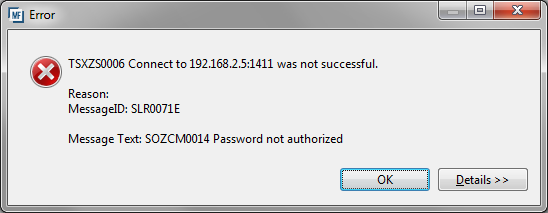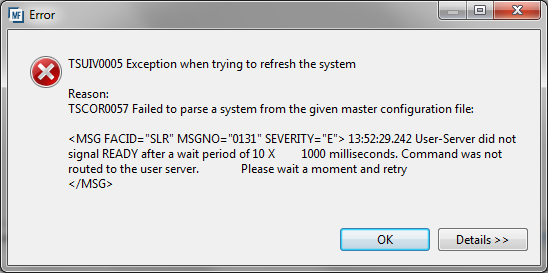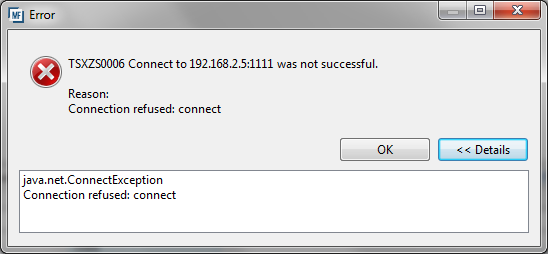Introduction
This guide is meant as a help for error situations that can be traced back to the Workflow Manager.
Generally, we distinguish between expected and unexpected error situations. For example, an expected error situation would be one when the user enters an incorrect connection password.
Unexpected error situations can further be grouped into situations that were foreseen by the software and those that were not. For example, a foreseen error situation would be that the connection to the remote system is broken, and an example of an unforeseen error situation would be a programming error in the software.
Depending on the type of error, the user or system administrator has different sources for help to deal with the situation.
For expected and unexpected but foreseen error situations, an error dialog in the Eclipse Workbench is displayed. For example:

The information in the dialog box should enable a user to handle this type of problem.
If the error was reported by the underlying z/Server software, a z/Server message ID is displayed in the dialog (in the example above this would be SLR0071E). The first three alphabetic characters of the message ID define the z/Server facility that detected the error. The facility’s acronym is followed by four digits which represent the sequential message number within the messages for this z/Server facility. A z/Server message ID ends with a character stating the severity of the message (I: informational, W: warning, E: error, S: severe error).
In some situations, the XML error message is returned in the original XML format, for example:

The values of the XML tags FACID, MSGNO and SEVERITY have to be concatenated to give the z/Server message ID, in this case SLR0131E.
The mapping between message prefix and z/Server facility is as follows:
| Message Prefix | z/Server Facility |
|---|---|
| API | Application programming interface (TCPIP) |
| BND | IEWBND (Binder) interface |
| CSI | Catalog search interface |
| DSC | Holder task configuration |
| EMC | Extended MCS interface |
| HLD | Holder task interface |
| IPC | Command task |
| JES | Job entry subsystem interface |
| LIC | License interface |
| MAL | Email interface |
| REC | Recovery exception handler |
| REX | REXX command environment |
| SJB | Started job interface |
| SLR | TSO scheduler interface |
| SPR | Standard pool routine |
| SRV | Server interface |
| SSI | Interface to z/OS SSI |
| STA | Started task interface |
| TAU | Eclipse client interface |
| UNI | Unicode conversion services |
| XML | XML system parser interface |
Detailed information about z/Server messages and how to handle them can be found in z/Server Messages and Diagnostics.
For unexpected but foreseen error situations, the exception caught is displayed in the text area shown when the Details >> button is pressed.

The exception type often gives a hint as to what caused the problem. In the example above, there is some kind of network connection problem, which could for example mean that the connection to the network was interrupted or that z/Server is not up and running.
If the information found in the error dialog is not sufficient to solve the problem, view the error log for further information. See Troubleshooting for details on how to access the error log, how to enrich it with debug information, and how to send that information to Micro Focus SupportLine.
Unexpected and unforeseen error situations will not normally produce an error dialog, but in some cases, information related to a software exception not caught is recorded in the error log.
Error messages lists all messages and describes the user, workflow modeler or server administrator response.
Troubleshooting contains instructions for the Application Workflow Modeler (the administrator) on how to find the cause of problems that may stem from Application Workflow Modeler, and offers solutions. It also describes the information that Micro Focus SupportLine needs when the Application Workflow Modeler cannot solve the problem.
Sample error situations is designed for support engineers to become accustomed to the way the software reacts during selected error situations.
Known issues shows currently known software errors, including tips on how to deal with them.